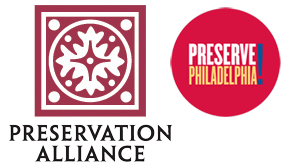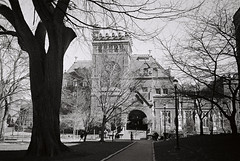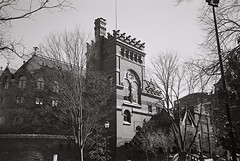Unlisted: Schlichter Jute Cordage Works
Written and drawn by Ben Leech
Unlisted is a series of portraits highlighting Philadelphia buildings not yet listed on the Philadelphia Register of Historic Places. To learn how to protect a building by nominating it to the Register, click here.
Address: 2155 Castor Avenue
Architect: Unknown
Built: c.1858
Buildings like the former Schlichter Jute Cordage Works (aka the Quaker Paper Products Building, aka Sterling Paper) usually
survive only in old sepia-toned photographs and doting lithographic portraits. Built in an era of dandified industry, when picturesque clocktowers, turrets, and other architectural flourishes were as common to factories as smokestacks and water tanks, these are buildings you can almost assume are long since demolished. Buildings like the Stetson Hat Factory and Schmidt’s Brewery. Buildings that inspire that most common of laments, “Man, it’s a shame they tore that down.”
But the Schlichter is still very much with us, inspiring an altogether different thought: “Man, how did they miss this one?” It stands in a largely nondescript corner of Kensington, down the street from Target and Home Depot. It is still occupied, presumably by the Sterling Paper Company, but is draped in an aura of mystery. And graffiti. And strange signage. Where former tenants once
matter-of-factly painted their names along the cornice lines of the building, the brick walls now inexplicably proclaim, “THERE IS NO CLOCK WHEN ITS TIME TO FLY” and “WE WILL NEVER FORGET YOU YOU TURN AROUND AND YOU COME BACK REMEMBER.” This is an architectural non-sequitor of the most welcome kind.
The New Batch
A lot of preservation organizations these days are turning their attention toward mid-20th century Modernism. While the questions of “what specifically?” and “how?” continue to spawn debate, the question of “why” is well answered. At least within the preservation community (if not yet in other circles), it is accepted that mid-century Modern buildings are potentially historical and call for proactive measures in terms of both planning and materials conservation.
The National was one of the first postwar buildings to be added to the Philadelphia Register, but that fact shouldn’t give us a false sense of security. Today there are only 7 individually-nominated Modern buildings, and, with the exception of The National, they’re by the big names (Louis Kahn, Richard Neutra, I. M. Pei, et al). There are so many more. Certainly not all warrant the formal protection of the Register (and to push for what Robert Venturi has called “pure” preservation only damages the credibility of the profession). Many are architecturally derivative or culturally insignificant. But all are growing older by the day. We’re going to miss some of them. Or, even if we never do, future Philadelphians will.











